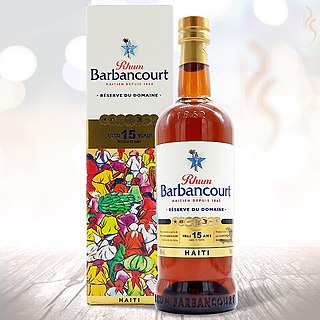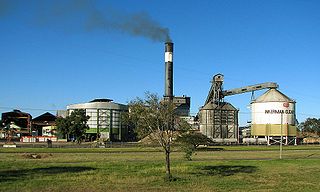
Mojito is a traditional Cuban punch. The cocktail often consists of five ingredients: white rum, sugar, lime juice, soda water, and mint. Its combination of sweetness, citrus, and herbaceous mint flavors is intended to complement the rum, and has made the mojito a popular summer drink.

Caipirinha is Brazil's national cocktail from São Paulo, made with cachaça, sugar, and lime. The drink is prepared by mixing the fruit and the sugar together, then adding the liquor. This can be made in a single large glass to be shared among people, or in a larger jar, from which it is served in individual glasses.

Sugar plantations in the Caribbean were a major part of the economy of the islands in the 18th, 19th, and 20th centuries. Most Caribbean islands were covered with sugar cane fields and mills for refining the crop. The main source of labor, until the abolition of chattel slavery, was enslaved Africans. After the abolition of slavery, indentured laborers from India, China, Portugal and other places were brought to the Caribbean to work in the sugar industry. These plantations produced 80 to 90 percent of the sugar consumed in Western Europe, later supplanted by European-grown sugar beet.

Rhum Barbancourt is rum produced from pure sugar cane juice and bottled in Haiti by Société du Rhum Barbancourt. The distillery is one of Haiti's oldest institutions, and its rum is the country's most famous export, widely regarded as among the finest rums in the world for over 150 years.

Capesterre-de-Marie-Galante is a commune on the island of Marie-Galante, in the French overseas region and department of Guadeloupe, itself in the Lesser Antilles.

Sugarcane juice is the liquid extracted from pressed sugarcane. It is consumed as a beverage in many places, especially where sugarcane is commercially grown, such as Southeast Asia, the Indian subcontinent, North Africa, mainly Egypt, and also in South America. Sugarcane juice is obtained by crushing peeled sugar cane in a mill and is one of the main precursors of rum.

Sugarcane or sugar cane is a species of tall, perennial grass that is used for sugar production. The plants are 2–6 m (6–20 ft) tall with stout, jointed, fibrous stalks that are rich in sucrose, which accumulates in the stalk internodes. Sugarcanes belong to the grass family, Poaceae, an economically important flowering plant family that includes maize, wheat, rice, and sorghum, and many forage crops. It is native to the warm temperate and tropical regions of India, Southeast Asia, and New Guinea.

Rum is a liquor made by fermenting and then distilling sugarcane molasses or sugarcane juice. The distillate, a clear liquid, is often aged in barrels of oak. While associated with the Caribbean due to its Barbadian origin, rum is nowadays produced in nearly every major sugar-producing region of the world, such as the Philippines, where Tanduay Distillers, the largest producer of rum worldwide, has its headquarters.

Betty's Hope was a sugarcane plantation in Antigua. It was established in 1650, shortly after the island had become an English colony, and flourished as a successful agricultural industrial enterprise during the centuries of slavery. It was the first large-scale sugar plantation to operate in Antigua and belonged to the Codrington family from 1674 until 1944. Christopher Codrington, later Captain General of the Leeward Islands, acquired the property in 1674 and named it Betty's Hope, after his daughter.

The history of sugar has five main phases:
- The extraction of sugar cane juice from the sugarcane plant, and the subsequent domestication of the plant in tropical India and Southeast Asia sometime around 4,000 BC.
- The invention of manufacture of cane sugar granules from sugarcane juice in India a little over two thousand years ago, followed by improvements in refining the crystal granules in India in the early centuries AD.
- The spread of cultivation and manufacture of cane sugar to the medieval Islamic world together with some improvements in production methods.
- The spread of cultivation and manufacture of cane sugar to the West Indies and tropical parts of the Americas beginning in the 16th century, followed by more intensive improvements in production in the 17th through 19th centuries in that part of the world.
- The development of beet sugar, high-fructose corn syrup and other sweeteners in the 19th and 20th centuries.

There are two heritage railways in Kauai, the birthplace of Hawaiian railroading. It was added to the National Register of Historic Places on January 19, 1979.

Rhum agricole is the French term for sugarcane juice rum, a style of rum originally distilled in the French Caribbean islands from freshly squeezed sugarcane juice rather than molasses. Rhum is the term that typically distinguishes it in French-speaking locales from the rum made with molasses in other parts of the West Indies.

A sugar cane mill is a factory that processes sugar cane to produce raw sugar or plantation white sugar. Some sugar mills are situated next to a back-end refinery, that turns raw sugar into (refined) white sugar.

José Ramon Fernández, 1st Marquis of La Esperanza (1808–1883), was the wealthiest sugar baron in Puerto Rico in the 19th century. He was also one of the most powerful men of the entire Spanish Caribbean. He owned an immense plantation of nearly 2300 acres on the northern coast of Puerto Rico, and a sugar mill with an advanced steam engine. His wealth and political connections gave him the power to convince the Spanish Colonial government in the island to split the municipality of Manati in two, and thus found the municipality of Barceloneta.

Ageston Sugar Plantation was a sugar plantation established in 1866 on the Logan River at Alberton, Gold Coast, Queensland, Australia. It was one of a number of early plantations which pioneered the region's sugar industry.

Beenleigh Rum Distillery is a heritage-listed rum distillery at Distillery Road, Eagleby, City of Logan, Queensland, Australia. The distillery produces Beenleigh Rum. It was built from c. 1890 to c. 1980. It was added to the Queensland Heritage Register on 6 March 2004.

Central Sugar Mill Ruins is a heritage-listed former sugar cane mill at Old Mill Road, Yengarie, Fraser Coast Region, Queensland, Australia. It was built from 1866 to 1890s. It was added to the Queensland Heritage Register on 5 December 2005.
Moreton Central Sugar Mill was a sugar milling facility in Nambour, Queensland, Australia owned by Bundaberg Sugar Ltd.
Takamaka Rum is a brand of rum that is distilled, aged and blended in the Seychelles, at the Trois Frères Distillery, on the main island of Mahé. The distillery has been operating since 2002, and was founded by the d’Offay brothers, Richard and Bernard d’Offay. It is the first and only commercial rum producer and exporter in Seychelles.

A beet sugar factory or sugar factory, is a type of sugar production facility that produces sugar from sugar beets. Nowadays most sugar factories also act as a sugar refinery. The first beet sugar factory was founded in 1802.


















